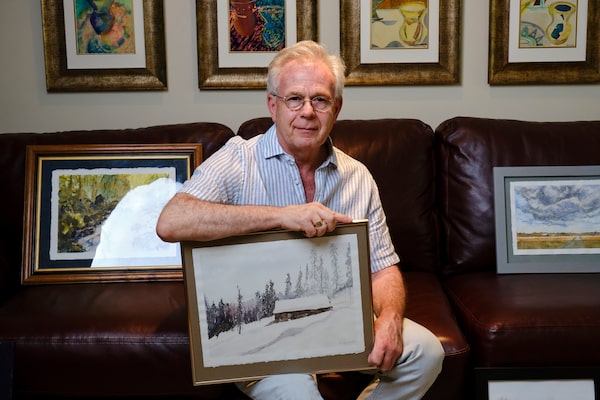
Peter Waind at his home in Waterloo, Ont. Once he retired, Mr. Waind started taking courses to pursue a long-time passion for drawing and painting.Alicia Wynter/The globe and mail
It was after retiring from his career as an ophthalmologist in 2020 that Peter Waind was able to reignite his dream of becoming an artist.
He took some art courses as an undergraduate student, and did a bit of photography over the years, but the demands of his ophthalmology practice and surgery schedule always took precedence.
Once retired, Mr. Waind started taking courses to pursue a long-time passion for drawing and painting.
“I like the expressiveness of paint when it’s a little bit out of control,” says the 68-year-old from Waterloo, Ont., describing it as “an opportunity for the other side of your brain to drive the bus.”
Last summer, one of his instructors at the Haliburton School of Art and Design in Haliburton, Ont., urged him to enroll in the college’s drawing and painting program in the fall. Mr. Waind, one of three mature students in his class, graduated in the spring and was “thrilled and surprised” to be awarded for the highest achievement in the course.
More seniors are revisiting their love for art in their retirement years as a way to express themselves and pass the time. The good news for retirees is that you don’t need an artistic background to take up drawing, painting or other art forms, says Kate Dupuis, the Schlegel innovation leader at the Sheridan Centre for Elder Research in Oakville, Ont.
“Some of our work is to redefine what being artistic or creative means to people and to really emphasize the fact that everyone has creativity and self-expression inside of them, regardless of whether you’ve lived your whole life without picking up a brush,” she says.
Research shows that participating in a creative activity, such as drawing or painting, is also good for your health – everything from reducing stress to increasing social engagement and improving cognition – which is increasingly important as we age.
“We know from research that engaging in the arts … can be very calming,” Dr. Dupuis says. “Some artists talk about this concept of flow, where you get into a meditative state when you’re creating, and time passes by without you really noticing.”
And you don’t have to take classes to be an artist or receive some of the benefits, she says.
“There’s a lot of different avenues from, ‘I’m going to do it at home by myself and see how it goes,’ all the way to taking courses from trained artists in your community,” Dr. Dupuis says.

Some of Mr. Waind's work.Alicia Wynter/The Globe and Mail
Carol Matson, a drawing and painting instructor at the Art Gallery of Ontario (AGO), says many of her students are retirees or about-to-be retirees with backgrounds as teachers, doctors, lawyers and empty nesters.
“You get people who haven’t picked up a paintbrush since they were six years old, and you get people who had gone to art school but over the years had gotten another job and given up on that part of their life and are coming back to it,” she says.
“I always tell people, never compare yourself to anyone else when starting the course because there are people from so many backgrounds.”
Retirement offers a great opportunity to take up the arts, Ms. Matson says.
“We’re all gifted with creativity as a child. As a retired person, maybe that’s your chance to go back to being childlike,” she says, adding that when students spend hours working on a painting or a drawing in class, “the rest of the world goes away.”
“It opens up a whole new world for some people who never thought they could express themselves in this manner,” she says.
Mr. Waind is an example of how art can become a fulfilling passion in retirement. He now has a website for his art, and two pieces were shown at an art show in Fenelon Falls, Ont., last fall. One of his photographs was also accepted at a juried show in Lindsay, Ont.
He says an art instructor – not one of his – recently offered him $150 for one of his watercolours. He wasn’t willing to sell it.
“That watercolour was the first time I made something where I thought, ‘Oh, that has something,’” Mr. Waind says. “There’s a little maturity. It’s neat the way it’s composed. There’s some dignity in some of the brush strokes.’”
Still, he says it was a pivotal moment in his latest chapter as an artist.
“It was a milestone … for me, thinking, ‘maybe I’m going to be something more than a dabbler,’” he says.

Interested in more stories about retirement? Sixty Five aims to inspire Canadians to live their best lives, confidently and securely. Read more here and sign up for our weekly Retirement newsletter.